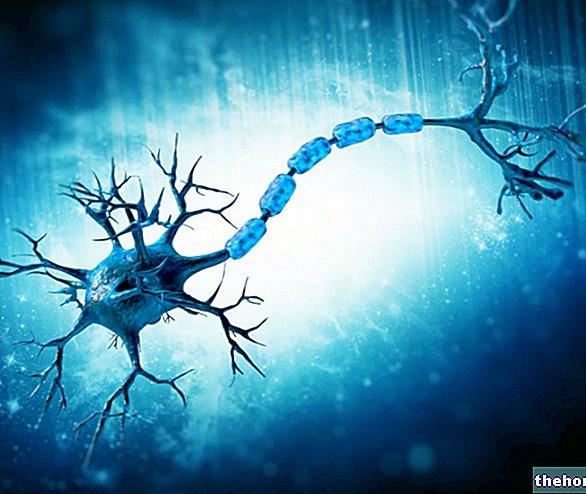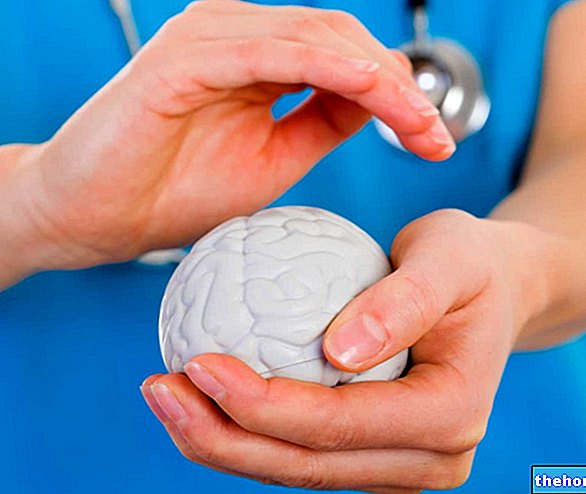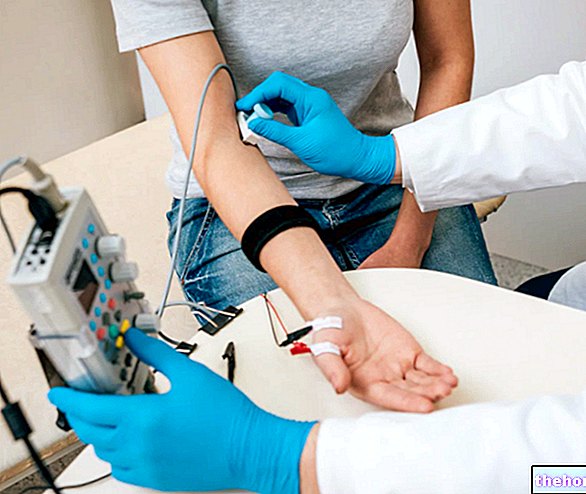
The symptoms of multiple sclerosis can be mild, such as numbness in the limbs, or severe, such as loss of vision; the progress and severity of the symptoms of this disease are unpredictable and vary from individual to individual.
In multiple sclerosis, there is an attack of the immune system against the central nervous system; it is also thought that the disease has a genetic component, which depends on the susceptibility of each individual, and is also influenced by various environmental phenomena.
Several researchers believe that multiple sclerosis is an autoimmune disease; some specialists, however, disagree with this definition, as the specific target of multiple sclerosis has not yet been identified.
Among the nerve components susceptible to attack by the immune system, myelin is mainly represented; in patients with multiple sclerosis, in fact, the myelin is damaged, as well as the nerve fibers, and is covered with scar tissue.
Even today, multiple sclerosis sufferers cannot count on a specific cure; however, there are a number of drugs and other treatments available to them that have proven effective in controlling the disease.
Often disabling, multiple sclerosis appears to be, according to most experts, an autoimmune disease; to characterize this disease, in fact, is the aggression operated by the immune system against the central nervous system.
More precisely, multiple sclerosis attacks and damages first of all myelin, which is the fatty substance that surrounds and protects the nerve fibers in the central nervous system and which is involved in the correct transmission of nerve signals along the various components of the central nervous system.
Since the damage it produces to myelin leads to the permanent deterioration of this fatty substance in the long run, experts describe multiple sclerosis as a demyelinating disease.
Why is it called multiple sclerosis?
Multiple sclerosis is called this because, in the various areas where it is damaged (multiple), the myelin of those suffering from this disease develops scar tissue (sclerosis), in place of the normal tissue component.
Meaning of sclerosis
In medicine, the term "sclerosis" indicates a process of hardening of an organ, or of a considerable part of it, due to the "increase in" scar tissue "(connective-fibrous) and the regression of normal parenchymal tissue.
Epidemiology
Multiple sclerosis is the most common autoimmune disease affecting the central nervous system.
Research dating back to 2015 reported that around 2.3 million people in the world were affected at that time.
Prevalence epidemiological studies have found that multiple sclerosis is more common in Northern Europe, North America, Southeast Australia and New Zealand, while it is less common in Tropical and Subtropical regions.
For reasons yet to be clarified, multiple sclerosis is 2 to 3 times more common in women than in men.
As a rule, most of the diagnoses of multiple sclerosis occur between the ages of 20 and 50, which means that the disease tends to arise at this stage in the life of the human being; however, it is not excluded that they can get sick with sclerosis. also young people (according to some statistics, 3-5% of new cases concern children and adolescents under 16 years).
Today, the number of multiple sclerosis diagnoses per year is greater than it used to be; this is most likely due to improved diagnostic techniques and greater knowledge of the disease.
The statistics of multiple sclerosis in Italy
According to what is reported on the website of the Italian Ministry of Health, in Italy:
- There are 122,000 cases of multiple sclerosis diagnosed;
- The disease affects, on average, 1 person in 500 (this figure varies from region to region);
- Each year, 3,400 people are diagnosed with multiple sclerosis.
Who First Described Multiple Sclerosis?
The French neurologist and pathologist Jean-Martin Charcot first described the clinical picture of multiple sclerosis in 1868.
clinically isolated (CIS): it is characterized by a neurological episode indicative of multiple sclerosis, whose duration is at least 24 hours and whose origin is a damage to the myelin of the central nervous system.Being affected by CIS does not mean that you are sick with multiple sclerosis or that you will necessarily develop this disease; this latter event is more likely to occur when the neurological episode is associated with myelinated brain lesions visible on magnetic resonance imaging.
Under these guises, multiple sclerosis alternates acute episodes (called "attacks" or "relapses"), in which there is a sudden worsening of neurological functions, to phases of remission, in which partial or complete recovery occurs and in which the disease does not progress.
According to statistics, between 75 and 85% of people diagnosed with multiple sclerosis have this form of the disease.
The peculiarities of SMPS are a constant worsening of neurological functions and a progressive accumulation of disability, in the absence of noteworthy moments of remission.
Several studies have shown that at least 50% of relapsing MS cases with remission develop the secondary progressive form within 10 years of the first diagnosis.
Currently, long-term data are not yet available to show that today's treatments are able to postpone the transition between the two aforementioned forms.
According to statistics, 10-15% of people diagnosed with multiple sclerosis have the disease in the PPMS form.
Sometimes, patients with PRMS may feel a sense of recovery after relapses; however, it is not a real remission and the disease continues in any case in its neurodegenerative course.
According to statistics, the SMPR form is very rare and affects only 5% of people diagnosed with multiple sclerosis.
What is a multiple sclerosis attack / relapse?
When we talk about attacks or relapses of multiple sclerosis, we refer to the appearance of new symptoms or the worsening of pre-existing symptoms, all for the duration of at least 24 hours and in the absence of fever or conditions of an infectious nature.
). The exact antigen or target that causes immune cells to respond with a myelin attack remains unknown to date. However in recent years, researchers have been able to identify: which immune cell prepares the attack, some of the factors which induce cells to attack myelin and some receptors that seem to be "attracted" to myelin to initiate the process of myelin destruction. Obviously the studies are still ongoing.
In multiple sclerosis, damage to the myelin of the central nervous system interferes with the transmission of nerve signals between the brain, spinal cord and other parts of the human body (remember that myelin is a component of nerve fibers involved in the transmission of nerve signals).
This alteration of nerve transmission causes the primary symptoms of multiple sclerosis, which vary depending on where the damage occurs.
During the course of the disease, some symptoms come and go, while others may be more lasting.
Common symptoms of multiple sclerosis include:
- Tiredness, fatigue and weakness. Found in about 80% of patients, the sense of fatigue is such that it can seriously interfere with the activities of the affected person, both at work and at home;
- Sense of numbness in the face, body and / or extremities (limbs);
- Difficulty walking, coordination disorders and balance problems
- Bladder disorders. They can include urgency to urinate, urinary incontinence and difficulty completely emptying the bladder (urinary retention);
- Intestinal disorders. Constipation and difficulty holding gas or stool are reported;
- Visual disturbances. They can consist of blurred vision, nystagmus, optic neuritis, impaired color vision, pain in the eyes during their movement and loss of vision.
For many people with multiple sclerosis, visual disturbances are the first symptom of the disease; - Dizziness. They are related to balance problems;
- Sensitivity disturbances. They can consist of an "alteration of touch and a reduction in sensitivity to heat, cold and pain;
- Ache. It affects just over 50% of patients and can consist of acute but transient sensations, tenuous but chronic sensations, heartburn, musculoskeletal pain or tension.
The sites most involved are the back, abdomen and face. - Cognitive disturbances. They affect more than 50% of patients and can consist of memory and learning problems, difficulties in maintaining concentration, attention difficulties, calculation problems, inability to perform operations of a certain complexity and problems in perceiving correctly the "environment;
- Sexual disorders. For male patients, erectile dysfunction and premature or absent ejaculation are reported; for female patients, however, difficulty in reaching orgasm and loss of sensitivity in the genital area.
- Mood changes and depression;
- Spasticity. It can include muscle stiffness and involuntary spasms that complicate movement.
It is usually felt in the lower limbs; however, it can also affect the upper limbs;
These particularly common manifestations of multiple sclerosis may be accompanied by other, less frequent symptoms, such as speech disturbances, hearing problems and tremors.
(anamnesis), a neurological exam, a blood test, lumbar puncture (spinal fluid analysis) and some instrumental tests, including MRI of the brain and spinal cord and the so-called evoked potential test.and pharmaceuticals - which have been shown to slow the course of the disease (these are the so-called multiple sclerosis-modifying drugs).
Furthermore, we must not forget the existence of medicines and therapies that are effective in controlling the so-called attacks, and treatments useful for the management of certain typical symptoms of multiple sclerosis.
For some time now, the medical-scientific community has been trying to understand the causes of multiple sclerosis, in order to find a more specific cure; thanks to advances in medicine, research in this direction is taking important steps, however question marks still remain.
For further information: Drugs to treat Multiple SclerosisMultiple Sclerosis Modifying Drugs
Multiple sclerosis-modifying drugs can have the following effects:
- Slow down the course of the disease and the progressive disability that follows;
- Decrease the frequency and intensity of so-called attacks;
- Reduce the accumulation of lesions (damaged areas) in the myelinated nerve fibers of the brain.
These drugs include:
- Interferon beta (eg: Betaferon, Rebif, Avonex, Extavia);
- Glatiramer acetate (ex: Copaxone);
- Fingolimod (ex: Gilenya);
- Dimethyl fumarate (ex: Tecfidera);
- Teriflunomide (eg: Aubagio);
- Siponimod (ex: Mayzent);
- Natalizumab (ex: Tysabri);
- Mitoxantrone (ex: Novantrone).
These are drugs that clearly require a medical prescription and have various side effects, sometimes even very important ones.
The choice of one drug over another depends mainly on the form of multiple sclerosis in progress.
Therapies for the control of relapses of multiple sclerosis
Briefly, for the control of the "attacks" of multiple sclerosis, the available therapies are some cortisone drugs and plasmapheresis (separation of the blood plasma from the corpuscular elements of the blood).
As for cortisone drugs, the choice generally falls on oral prednisone or intravenous methylprednisone.
As for plasmapheresis, it should be noted that it is a treatment reserved only for those patients who do not respond to cortisone therapy.
Remember that ...
Cortisone drugs have various side effects, in some cases even relevant.
Treatments for the Symptoms of Multiple Sclerosis

Treatments to relieve the symptoms of multiple sclerosis again include medications and physiotherapy.
Medicines
Among the drugs used in the management of multiple sclerosis symptoms, the following are noted:
- Medicines to reduce muscle spasms and stiffness (e.g. the muscle relaxants baclofen and tizanidine);
- Medicines to reduce the sense of chronic fatigue (eg: amantadine, methylphenidate hydrochloride);
- Dalfampridine, which serves to improve walking speed;
- Medicines for erectile dysfunction, depression, chronic pain and bladder and bowel problems.
Physiotherapy
Physiotherapy for the multiple sclerosis patient involves exercises of stretching and muscle strengthening, with the ultimate goal of alleviating motor and coordination problems, and the sense of weakness.
Read also: Diet for Multiple SclerosisWhen to start Multiple Sclerosis Therapy?
Numerous clinical studies have shown that the control of the progression of multiple sclerosis is better when therapy is initiated in the early stages of the disease.
See other articles tags Multiple Sclerosis




























